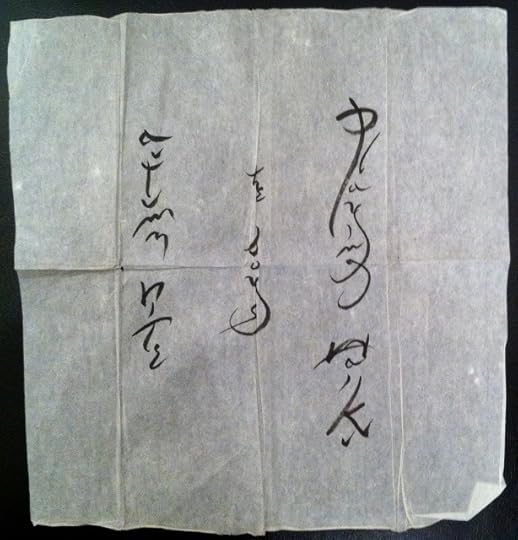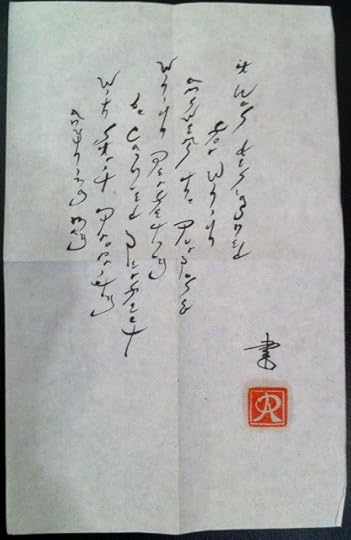The Point at Which Letters are What They Are
I have just spent a couple of hours organizing my papers on my third floor because I need to put all of them away so a guest can sleep up there during the course of the festivities surrounding my daughter Erin's wedding this weekend. As I came downstairs, I realized I really should be working on the painting we need to do this week. There's a point at which busyness leads to poor focus, and I am there.
In point of fact, it has been a week since I gave a little performance at the Dumbo Arts Festival, and I've said not a word about that, not to mention the myriad of other events I've never reasonably reviewed. And tonight I won't do much better, but I'd like to say a few words about the work of Alan Rosner, who showed up at Central Booking to see me just before my performance but did not stay for the performance itself.
 Alan Rosner, "autumn nite"
Alan Rosner, "autumn nite"
Alan actually came to meet me to meet a Huth, because his sister-in-law is a Huth, and I was impressed to hear a stranger pronounce my name correctly (rhymes with Booth, and don't add a y-sound after the H). At first I thought that was going to be the entirety of our discussion: the rarity of the name Huth, my possible but unlikely connection to his sister-in-law (my father was the last of his line until he had six children and, now, twelve grandchildren). But, just before leaving, Alan pulled two pieces of folded paper out of his wallet and opened them before me.
At first glance, these seemed to be examples of Asian calligraphy, but quickly I realized the were pieces of trompe l'oeil calligraphy: poems written in English but using outré forms for the letters. The one above reads "autumn nite / the boys / playing Haiku." These are serious pieces, but also playful, and some of the strokes of the pen here I really love, like that long leg of the p in "playing."
 Alan Rosner, "anything may"Alan has a website called Rosner that is dedicated to the various forms of art he practices, including sculpture, and he has a section there entitled Eurasian Calligraphy that provides more examples of these works. The second example here is much longer and more complicated, but also (I'd say) a more successful job of camouflaging. Alan says these can be read in either direction (left to right or right to left), so work on this one a bit.
Alan Rosner, "anything may"Alan has a website called Rosner that is dedicated to the various forms of art he practices, including sculpture, and he has a section there entitled Eurasian Calligraphy that provides more examples of these works. The second example here is much longer and more complicated, but also (I'd say) a more successful job of camouflaging. Alan says these can be read in either direction (left to right or right to left), so work on this one a bit.
And he doesn't share my interest in the works of Xu Bing, which sometimes resemble these in affect. Alan believes Xu Bing's work is not language, thinking here of Xu Bing's asemic works. But Xu Bing also does remarkable pieces of trompe l'oeil calligraphy where characters seem to us to be real Chinese characters but then we see hidden within the complications of each character an English word.
My thanks to Alan for stopping by on a busy day under a bridge in Brooklyn.
ecr. l'inf.
In point of fact, it has been a week since I gave a little performance at the Dumbo Arts Festival, and I've said not a word about that, not to mention the myriad of other events I've never reasonably reviewed. And tonight I won't do much better, but I'd like to say a few words about the work of Alan Rosner, who showed up at Central Booking to see me just before my performance but did not stay for the performance itself.
 Alan Rosner, "autumn nite"
Alan Rosner, "autumn nite"Alan actually came to meet me to meet a Huth, because his sister-in-law is a Huth, and I was impressed to hear a stranger pronounce my name correctly (rhymes with Booth, and don't add a y-sound after the H). At first I thought that was going to be the entirety of our discussion: the rarity of the name Huth, my possible but unlikely connection to his sister-in-law (my father was the last of his line until he had six children and, now, twelve grandchildren). But, just before leaving, Alan pulled two pieces of folded paper out of his wallet and opened them before me.
At first glance, these seemed to be examples of Asian calligraphy, but quickly I realized the were pieces of trompe l'oeil calligraphy: poems written in English but using outré forms for the letters. The one above reads "autumn nite / the boys / playing Haiku." These are serious pieces, but also playful, and some of the strokes of the pen here I really love, like that long leg of the p in "playing."
 Alan Rosner, "anything may"Alan has a website called Rosner that is dedicated to the various forms of art he practices, including sculpture, and he has a section there entitled Eurasian Calligraphy that provides more examples of these works. The second example here is much longer and more complicated, but also (I'd say) a more successful job of camouflaging. Alan says these can be read in either direction (left to right or right to left), so work on this one a bit.
Alan Rosner, "anything may"Alan has a website called Rosner that is dedicated to the various forms of art he practices, including sculpture, and he has a section there entitled Eurasian Calligraphy that provides more examples of these works. The second example here is much longer and more complicated, but also (I'd say) a more successful job of camouflaging. Alan says these can be read in either direction (left to right or right to left), so work on this one a bit.And he doesn't share my interest in the works of Xu Bing, which sometimes resemble these in affect. Alan believes Xu Bing's work is not language, thinking here of Xu Bing's asemic works. But Xu Bing also does remarkable pieces of trompe l'oeil calligraphy where characters seem to us to be real Chinese characters but then we see hidden within the complications of each character an English word.
My thanks to Alan for stopping by on a busy day under a bridge in Brooklyn.
ecr. l'inf.
Published on October 03, 2010 20:57
No comments have been added yet.



